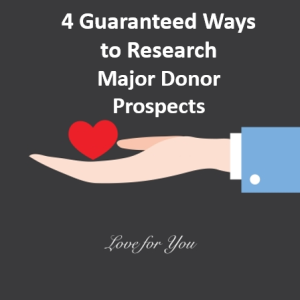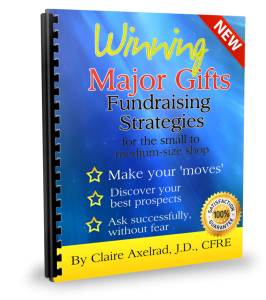MAJOR GIVING.
It’s one of those terms nonprofiteers bandy about freely within the grand scheme of things to be devoutly wished for.
But precisely what constitutes a major gift, and where are they to be found? These can be difficult to pin down for your particular nonprofit.
You have to know (1) what you’re looking for, and (2) where to look.
Today I’ve asked an experienced prospect researcher, Ryan Woroniecki, Vice-President of Donor Search, to give us some practical major donor prospect identification guidance. Ryan, please take it away!
SOME EXPERT MAJOR DONOR PROSPECT IDENTIFICATION ADVICE:
On the one hand, we can all grasp what a major gift is. Major individual gifts are the largest donations your organization receives (outside of the occasional planned gift and even rarer, mega gift). We also know securing major gifts is the most cost-effective method of fundraising.
When you think about major giving from organization to organization, you have to address the variations. Yes, major gifts are large donations across the board. Yet what qualifies as major can be drastically different from nonprofit to nonprofit.
Furthermore, while you might know the exact traits that make up a major gift donor at one organization, those details are going to vary the minute you examine a new organization.
There’s good news though. As long as you define major giving according to your organization’s fundraising capacity and do the same for your donor pool, you’ll be in good shape.
The latter part of that statement is where prospect research enters the mix.
Successful use of prospect screening can highlight who among your prospect and donor list are the best candidates for major giving. You just need to know which identifying factors you should be looking at.
These four identifying factors will guide you as you search for major giving prospects.
If you’d like more information and resources on major gifts prior to reading further about prospect identification, check out this helpful roundup.
#1: Past Giving
You want to find major gift prospects who have a history of giving. Anywhere. You’re looking for folks who are philanthropic.
Next, it’s good to find prospects who’ve given to organizations that have a mission that’s in some measure related to yours. You’re human service; they’re human service. You’re arts; they’re arts. You’re civic-minded; they’re civic-minded.
Note the frequency of the prospective donor’s philanthropy. Even if the gifts are smaller than you’d need for a major giving program, the act of making consistent donations speaks to the prospect’s charitable inclinations and openness to being cultivated as a major gifts donor.
Look into publicly accessible annual reports from other nonprofits to compare your donor data and that of other organizations. If you’re having trouble finding enough information through these means, you might consider subscribing to the services of a prospect screening company that has those capabilities.
#2: Past Giving to Your Organization
Past giving is generally a great trait to look for, but past giving to your organization in particular is even better. When a prospect has a giving history with your organization, half the battle has been won. You have acquired and retained this donor.
Check your database to see who fits the bill.
In most cases, the first gift a donor gives is not going to be the largest amount that donor is capable of. Instead, people tend to work their way up to major giving, regardless of whether or not they started out with enough money to do so from the first donation.
The prospect is already committed to your organization. As long as the donor has the means to do so, you have lined up a great major giving prospect.
As a side note:
If you have a truly dedicated donor who is not in the current financial position to allocate a major gift, you could approach the donor about planned giving. A planned gift is decided on in the present and physically given at a set point in the future, usually when the donor has passed away.
Although many planned gifts come from supporters as wealthy as major gift donors are, wealth and planned giving are not mutually exclusive. In fact, a dedicated donor who wants to but can’t afford to donate a major gift during their lifetime could go the planned giving route. That way, those generous funds are only given when the donor no longer needs them. But you can recognize them for their commitment now!
#3: An Active Relationship with Your Organization
Although frequent donations are telling, gifts are not the only way a supporter can engage with your organization.
To locate major gift prospects among your supporters, you’re going to see if any of your event attendees or dedicated volunteers have the financial capacity to give a major gift. That process could involve looking at traditional wealth markers or screening the participants to discover if they’ve given a major gift elsewhere.
For instance, you could cull through the attendee lists from your most recent formal event. Formal events tend to draw a major giving crowd and are designed, in part, to build relationships with major giving prospects.
You can screen the guests to see who the best major giving candidates are. This can be performed before or after the event. If done before, your fundraisers will know who to pay particular attention to. If done after, your fundraisers will know how they should follow up after the night’s proceedings.
#4: Business Connections to Your Organization
Asking for a major gift isn’t like asking for a stick of gum. You can’t jump to the ask without cultivating a relationship first. As you begin the cultivation process, being introduced by some mutual intermediary makes things far easier than starting with a cold call. Every little bit helps, so when a prospect is introduced to you by a trusted source, that prospect is more inclined to trust your organization.
Any kind of connection to your organization is welcome, whether personal or professional. This specific factor speaks to the professional side, because there’s quite a range of business connections that a prospect can have, warranting further explanation.
Prospects can be unknowingly connected to your cause through:
- Corporate philanthropy programs run by their employers.
- Co-workers involved in your work.
- Business associates who sit on the board of your organization.
- … and more!
There are many ways a prospect might be professionally tied to your cause and not even know it. Prospect research can lift the curtain on such connections and make your job of cultivating that major gift candidate less challenging.
Keep in mind that, generally speaking, knowledge of a prospect’s profession and career track offers a basic understanding of their capacity to give. Depending on what information is publicly available, you could uncover quite a bit about a prospect’s financial situation like stock ownership and estimated income.
————————
Begin with these four identifying major donor traits, but don’t stop here. Instead, use them as the launching point of your investigation. As you narrow down your prospect list, you’ll want to hone each of these factors so that they’re customized for the specifications of your major giving program.
No two major donor programs are alike. What they do share, however, is that they’ll be your greatest and most cost-beneficial source of fundraising.
 This is a guest post by Ryan Woroniecki, Vice-President of Donor Search, a prospect research, screening, and analytics company that focuses on proven philanthropy. Ryan has worked with hundreds of nonprofits and is a member of APRA-MD. When he isn’t working, he is an avid kickball player.
This is a guest post by Ryan Woroniecki, Vice-President of Donor Search, a prospect research, screening, and analytics company that focuses on proven philanthropy. Ryan has worked with hundreds of nonprofits and is a member of APRA-MD. When he isn’t working, he is an avid kickball player.
Photos courtesy of Freedigitalphotos.net
Want to Kick-Start or Ramp Up Your Major Donor Program?
It’s time for my most popular e-course of the year – Winning Major Gifts Strategies for the small to medium-sized shop! You can still grab the Early Bird deal before January 15th .
The course runs for six weeks, but it’s completely self-paced. Can’t get to it now? Save it until you’re ready.
Keep in mind: Giving USA reports that 72% of giving comes from individuals. Another 8% comes from individual bequests. So the lion’s share of philanthropy comes from people. Not foundations. Not businesses. Not events. And 80% or more of your annual giving will likely come from 20% or less of your individual donors. Having a robust major donor program is the key to long-term, sustainable fundraising.












You forgot donor surveys. 🙂
That’s so funny Greg. I’m actually writing an article about donor surveys next week. This was a guest post. 🙂
Thanks so much for reading and responding.